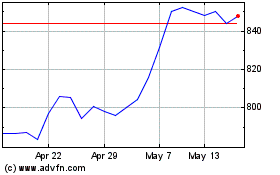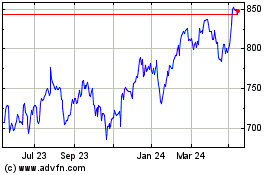By Simon Constable
Exchange-traded funds specializing in emerging markets have been
drawing tens of billions of dollars in new investment lately. But
not all countries are getting equal love from investors.
Over a period of about 16 months through mid-April,
exchange-traded funds specializing in emerging-markets stocks have
attracted about $84 billion in cash inflows. However, a cool 80% of
that went to stocks of companies in just five countries: China,
South Korea, India, Brazil and Taiwan, according to statistics from
financial-data provider EPFR, a subsidiary of U.K. events and
publishing company Informa PLC. (Some investors view Taiwan and
South Korea as developed markets.)
Another takeaway: China's haul amounted to 41% of the total,
versus 11% for India, and 0.6% for Russia. ETFs specializing in
Chinese stocks include SPDR S&P China (GXC) and iShares MSCI
China (MCHI).
In other words, investors aren't throwing money at this part of
the market blindly. Some countries are getting a lot more of the
action than others.
"Rather than buying broadly diversified funds, investors realize
that there will be winners and losers," says Jack Ablin, founding
partner, and chief investment officer at Chicago-based
wealth-management firm Cresset Capital Management. "They are
picking sides."
The proportion of ETF money betting on China during the 16
months in question was far larger than the country's current 31%
weighting in the MSCI Emerging Markets Index, a benchmark used
across the investing world. The same is true for India, whose 11%
share of the inflows compared with the country's MSCI index
weighting of only 9.5%.
Mr. Ablin says it makes sense for investors to choose countries
like India and China, which both feature large, fast-growing
economies. China, the world's second-largest economy, grew at an
annualized 6.4% in the latest reported quarter, compared with 3.2%
for the U.S. in the first quarter, according to data collated by
Tradingeconomics.com. India's recent GDP data, meanwhile, showed
annualized growth of 5.8%.
Given the similarity in the growth rates of India and China, it
could be seen as surprising that China ETFs took in $34.6 billion,
almost four times the $9.2 billion that India-focused ETFs drew.
But one big reason for the discrepancy is that China's stock market
became attractive again after a period of cooling off caused by
investor worries about signs of weakening in China's economy.
The narrative around the Chinese economy "is more compelling of
late," says Arthur Hogan, chief market strategist at
investment-banking firm National Securities Corp. While the
Shanghai Composite Index (China's version of the S&P 500) sold
off around 30% during 2018, says Mr. Hogan, that caused Chinese
stocks to fall to more attractive prices. That didn't happen in
India.
Mr. Hogan notes that the Chinese selloff was caused by slower
GDP growth, and worries that threats of tariffs between U.S. and
China were suggesting the start of possibly a "long, drawn-out
trade war."
Then two things happened. Earlier this year, the trade talks
appeared to be going well, and it became clear that the Chinese
government would boost the country's economy with a huge economic
stimulus.
"The improving narrative around both the U.S.-China trade talks
and the Chinese economy has acted like a magnet to emerging market
investors," says Mr. Hogan.
Economic overhauls, or the promise of them, also helped make
China attractive again to investors, says Kristina Hooper, chief
global-markets strategist at New York-based asset management firm
Invesco. Ms. Hooper contrasts the Chinese approach with that of
Russia, which appears to have done the opposite of wooing foreign
money.
Russia, Ms. Hooper says, "doesn't seem to have done anything
material to attract investors." The country also faces possible
retaliation from the U.S. after Moscow's reported interference in
the 2016 presidential election. That may help explain why investors
committed a mere $488 million to ETFs focused on Russia, 0.6% of
the total, during the recent 16-month period.
The lack of interest in Russia-focused ETFs is less surprising
than the indifference investors showed during the period for some
other countries.
Ms. Hooper says that Brazil, the largest emerging-markets
economy in the Western Hemisphere, would have attracted more ETF
investment if it were not for the elections held there last fall.
Uncertainty about a new government's economic policies generally
causes investors to feel cautious about committing capital.
Brazil's 6% of the inflows to emerging-markets ETFs over the 16
months was lower than its 7.6% MSCI index weighting.
Mexico also seems to have been overlooked by many
emerging-markets investors for reasons of uncertainty.
Mexico-focused ETFs attracted $2.8 billion, or 3% of the whole.
Still, that seems small when the economy of its major trading
partner just next door has been so strong.
"Mexico is certainly benefiting from the U.S. economic
situation, and that is likely to continue," says Ms. Hooper.
She says one likely reason for the subdued interest was
President Trump's desire to replace the North American Free Trade
Agreement with a renegotiated deal with better terms for the U.S.
The White House worked out a replacement pact, the
U.S.-Mexico-Canada Agreement, but that agreement has run into
resistance in Congress and has yet to be ratified by Canada or
Mexico.
Another country that Ms. Hooper thinks deserves more investment
than it is getting: Vietnam.
"Vietnam is a very strong growth story, and they are benefiting
from the U.S.-China trade war," she says. "It has very high growth
levels, and its economy has benefited from shifts out of
China."
The Southeast Asian nation's economy grew 6.8% in the first
quarter. It is also seeing outside direct investment into its
economy because companies are switching production from China to
Vietnam where labor is cheaper.
ETFs focused on Vietnam attracted $587 million over the period,
or 0.6% of the total inflows into emerging-markets ETFs.
Mr. Constable is a writer in Edinburgh, Scotland. He can be
reached at reports@wsj.com.
(END) Dow Jones Newswires
June 09, 2019 22:17 ET (02:17 GMT)
Copyright (c) 2019 Dow Jones & Company, Inc.
Informa (LSE:INF)
Historical Stock Chart
From Oct 2024 to Nov 2024

Informa (LSE:INF)
Historical Stock Chart
From Nov 2023 to Nov 2024
